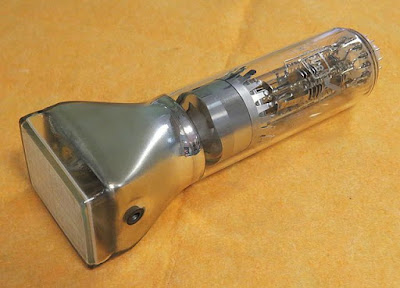AIM: To measure the phase difference between two signals
 |
| CRO |
Any signal is characterised by mainly three parameters, namely amplitude, frequency and phase. Therefore to compare two or more signals, these characteristics are to be compared. For signals of identical frequency and having equal amplitudes the only factor that may be compared is the phase.
APPARATUS: CRO, function generator, set of known values of resistances box
and capacitors.
FORMULAE
φ = tan –1 (1/2πf RC)theoretical = [sin-1 (Y1/ Y2)] expt
φ = phase difference between signals at X and Y i/p s.
R, C are resistance and capacitance in the circuit.
Y1 and Y2 are intercepts made by ellipse & its semi major axis on Y axis.
INTRODUCTION
Any signal is characterised by mainly three parameters, namely amplitude, frequency and phase. Therefore to compare two or more signals, these characteristics are to be compared. For signals of identical frequency and having equal amplitudes the only factor that may be compared is the phase.
THEORY:
Determination of phase difference between two signals:
If an ac voltage is applied to pure resistance(R),```````````````` the current through it is in phase with applied voltage. However if it is applied to pure capacitor(C), a phase difference of p/2 is introduced between voltage and current, where current leads the voltage. If the combination of R & C is used, the phase difference lies between 0 and p/2. This is the principle of the method used here.
The signal is applied at X input while voltage signal across R is applied at Y input of CRO. Since the frequency at two i/p s is same, an ellipse is obtained whose inclination depends on the values of R and C used. From this ellipse the phase difference can be obtained as sin-1y/x. Where x and y are the intercepts made by ellipse and its half major axis on the Y axis respectively. Theoretically the value of phase difference is found as
f = tan –1 (1/ 2 pf RC).
This can be shown as:
The impedance of the circuit with R and C in series is given as
Z = R + Xc.
Where Xc is the reactance offered by capacitor & is given as
Xc = (1/ 2pf RC)
Where, f is the frequency of applied voltage and
C is capacity of the condenser.
The phasor diagram for this circuit is as shown in fig. From the phasor diagram phase difference φ can found as
f = tan-1Xc/R = tan–1 (1/2pfRC).
Superposition of two SHMs:
Let two signals with phase difference f applied at X & Y inputs of CRO be represented by two SH waves; X = X0 sin(ωt) ----------- (1)
& Y = Y2 sin (ωt+f) ---------- (2)
SoY/Y2 = sin (ωt+φ) ----------- (3)
= sin ωt. cos φ + cos ωt. sin φ
Y/Y2 = X/X0 cos φ + {1 - (X/X0)2}1/2 sin φ ------------–from(1)
(Y/Y2)2 = [(X/X0) cos φ + {1 - (X/X0)2}1/2 sin φ ] 2
= (X/X0)2 cos2 φ +2 (X/X0) cos φ sin φ {1- (X /X0)2}1/2 + sin 2φ. {1-(X /X0)} 2
This equation represents ellipse inclined at an angle φ with X axis. The Y intercept made by ellipse denoted by Y1 is given by putting X = 0 in above equation; which gives: sin φ = ± (Y1/Y2)
Y2 is the amplitude of the wave along Y axis. It is found by taking projection of semi major axis of ellipse on Y axis.
\ φ = sin-1 (Y1/Y2)
The switches, controls of the front panel of CRO are explained in detail
PROCEDURE:
1. Determination of phase difference using CRO in X-Y mode.
1. Make the connections as shown in the figure.
2. Adjust the position knobs so that spot lies at centre of the screen.
3. Adjust the frequency of function generator to 50 Hz.
4. Set the `mode’ selector at `X-Y’ position.
5. Set value for R = 2 kΩ and C = 2.756µF.
6. After getting connections checked from teacher switch on CRO and function generator.
7. Keep`mode’ knob on `dual’ position to get two sign waves.
8. Change ‘mode’ selector to `X-Y’ mode to get an ellipse/ circle.
9. Adjust the volt/div knobs so that sufficiently large ellipse is obtained. Ensure that the knobs are at the same positions.
10. Using the position knobs measure the intercepts on the Y-axis.
11. Repeat the procedure for different combination of R and C.
RESULT
1. The average value of unknown frequency is found to be
2. The phase difference j calculated for given R and C combinations are found to be
S.No
|
R(W)
|
C( μF)
|
j
|
1.
2.
3.
|
2K
1K
500W
|
2.756
3.183
3.675
|

MguecysZpresno_Toledo Matt Mueller https://wakelet.com/wake/7gMVzQ-bkMoFKfGC-0srk
ReplyDeletedephopilsblos
stigavFleo-fu Diana Claborn https://sector1podcast.wixsite.com/sector1/profile/lanetterowynadevidd/profile
ReplyDeleteacveluawest
elatid_ge Corey Pickell McAfee Internet Security
ReplyDeleteCyberLink PowerDVD
Avid Pro Tools
viarigsejee
Wsumpsufal_mu Wewere Tucson There
ReplyDeleteget
diotrucuntab